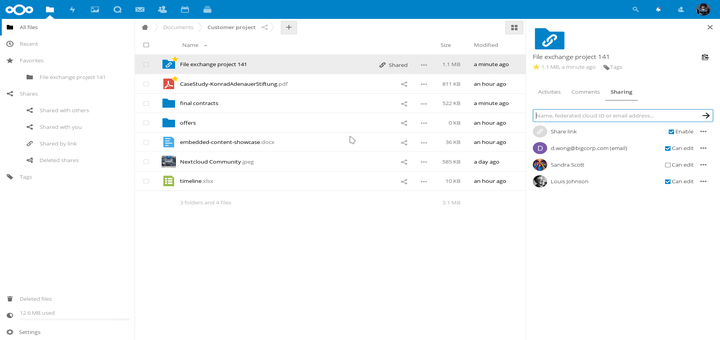


- HOW TO ADD ANOTHER USER NEXTCLOUD HOW TO
- HOW TO ADD ANOTHER USER NEXTCLOUD UPDATE
- HOW TO ADD ANOTHER USER NEXTCLOUD CODE
- HOW TO ADD ANOTHER USER NEXTCLOUD PASSWORD
Now, let me go through the services definitions: 1. Keeping the original file is just for the sake of backup, nothing else. You'll be editing this file later for the environment variables. mkdir -p ~/Nextcloud & cd ~/Nextcloudįor file in env.example docker-compose.yaml doĬopy the env.example file to.
HOW TO ADD ANOTHER USER NEXTCLOUD CODE
Otherwise, use the following shell code to create a directory named "Nextcloud" and download the files in there. The working git command is as follows: git clone & \ If you cloned the "tutorial-snippets" repository while deploying the reverse-proxy, just change your current directory to tutorial-snippets/Nextcloud. You can either clone our whole GitHub repository, or just download the necessary files. I recommend you download the files, and then go through everything to understand what's going on, there's no need for you to rewrite everything from scratch. You can either download that or rewrite them while reading the explanations. the compose file and the env files are already uploaded to our public GitHub repository. If you are using this tutorial in the future (from present time reference) and there is a much newer version of Nextcloud and MariaDB, please use those versions. I'm going with MariaDB, especially the image tag (or version) 10.5.9.įor Nextcloud, I'll use the version 21.0.0, this is the latest at the time of writing this article. There are two components here: one is the database, another is Nextcloud itself, or rather let's call it the frontend.įor the backend database, any MySQL-based database will work. You don't have a web service running on it just yet. On a successful deployment, you should get a 503 when trying to visit the IP address of the server that is hosting this reverse-proxy. docker network create netįinally, deploy the containers docker-compose up -d This is used in the docker-compose.yaml file. Discussed in brief in the next paragraph.Ĭreate a docker network named net. docker-compose.yaml: Biggest of them all.max_upload_nf: This file makes sure that you can upload files as big as 1 GB in size (the default is 2 MB).env and change the value of DEFAULT_EMAIL to your email Otherwise, just download the necessary files: mkdir -p ~/Reverse_Proxy & cd ~/Reverse_Proxyįor file in max_upload_nf env.example docker-compose.yaml do If using git, clone the whole repository: git clone & \ You can either use git, or wget to download the files. Since this is not a detailed article about the reverse-proxy deployment, I shall not go into the Compose file details. I have already prepared the compose files in our public GitHub repository.
HOW TO ADD ANOTHER USER NEXTCLOUD UPDATE
The reverse proxy deployment should be done using a separate Compose file so that you can restart or update web-services without disturbing your reverse proxy setup. If you are using Linode, I recommend you use our reverse-proxy-jwilder StackScript to easily deploy your server with everything already set up for you.
HOW TO ADD ANOTHER USER NEXTCLOUD HOW TO
If you're not using Linode, please go through my article on how to set up nginx-reverse-proxy with Docker. There are two ways you can set the Ngnix reverse proxy. This is not optional because you need let's Encrypt container for SSL. With reverse proxy, you can deploy several web services on the same server.
HOW TO ADD ANOTHER USER NEXTCLOUD PASSWORD
You'll need it for sending email notifications, password reset etc.ĭeploying Nextcloud server with Docker in reverse proxy


 0 kommentar(er)
0 kommentar(er)
